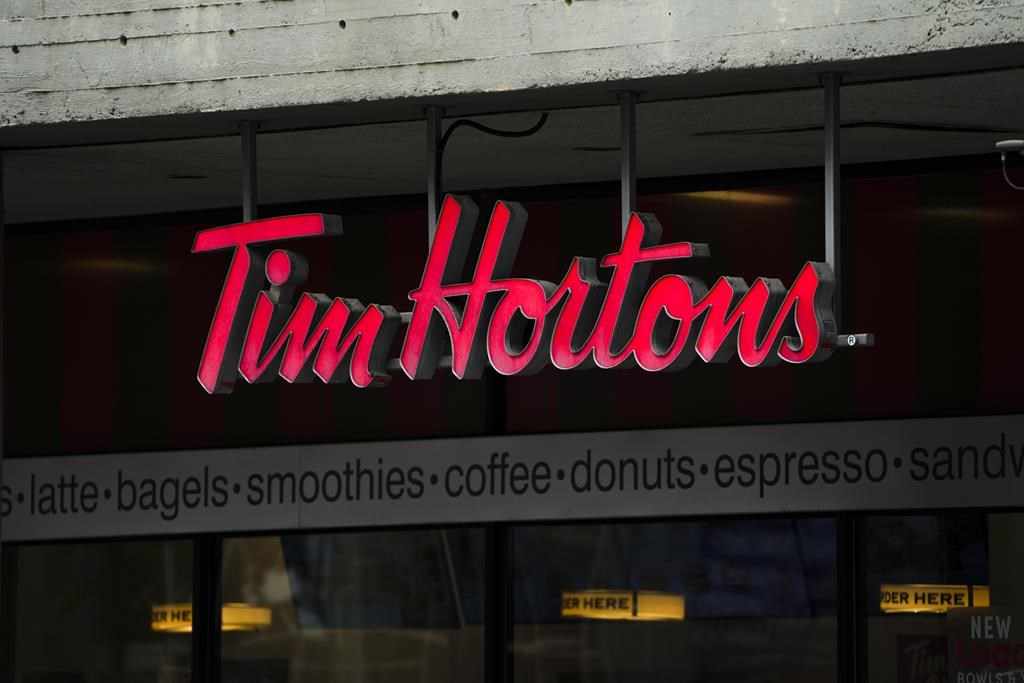Tim Hortons seeking more afternoon, evening sales as parent reports US$364M profit

Posted November 3, 2023 7:08 am.
Last Updated November 3, 2023 1:26 pm.
TORONTO — Long associated with morning coffee runs and breakfast, Tim Hortons is setting its sights on dominating the second half of the day too.
“We are really super excited about the opportunities to be had in the p.m. food area, so really serving more Canadians for lunch and dinner and in the afternoon,” said Axel Schwan, president of Tim Hortons Canada and U.S., in a Friday interview.
“That’s a big priority for us.”
The food services brand owned by parent company Restaurant Brands International Inc. has so far been focused on bolstering business in the latter portion of the day by building out its food offerings beyond breakfast sandwiches, coffee and doughnuts.
The company only began selling all-day breakfast a few years ago but now offers rice, chicken and veggie bowls, and has dabbled with burgers and pizza.
It recently introduced Twists, a buttery, flaky pastry that comes in four-cheese and everything flavours, and Dream cookies, which are premium treats stuffed or topped with ingredients like pecans, marshmallows, Reese’s and M&M’s.
“They have been a big hit with our (customers),” said Schwan.
“We have been serving millions of these cookies every month since June, when we actually launched them.”
Tim Hortons said its comparable store sales, a key retail metric that measures sales at stores open more than a year, rose 6.8 per cent in the third quarter compared with 9.8 per cent a year prior.
But becoming a heavyweight in the later-day portion of the quick-serve market comes with challenges. Rivals such as McDonald’s and Wendy’s have gained huge portions of dinner and afternoon snack sales and that time of day also has competition from sit-down restaurants, not to mention people eating at home.
At the same time, several economists and retailers have reported consumers are being more cost-savvy and increasingly seeking discounts as inflation, particularly in the food sector, remains high.
Duncan Fulton, RBI’s chief corporate officer, chalks up the conditions as part of the nature of being in the quick-service restaurant business.
“There’s always going to be market dynamics that are changing,” he said in the same interview as Schwan.
“And because we work in 100 countries around the world, we see a lot of different dynamics, sometimes actually opposing dynamics, in different parts of the world.”
Fulton’s remarks came the same day as RBI, which also owns Burger King, Popeyes Louisiana Kitchen and Firehouse Subs, warned of increases in commodity, labour and energy costs.
RBI said it has seen the war in Ukraine and COVID-19 trigger increases in inflation, foreign exchange volatility and rising interest rates which may be exacerbated by the conflict in the Middle East.
It warned the geopolitical tensions could have an adverse impact on its business, if the company and its franchisees are not able to adjust prices sufficiently without negatively affecting consumer demand.
On a Friday call with analysts, RBI executives said they haven’t seen any big changes in consumer behaviour in Canada yet.
Patrick Doyle, RBI’s executive chair, suspects the company’s chains will fare better than others because of their focus on value.
“They are not recession proof, but they are recession resistant,” he said.
RBI recorded a US$364 million profit in its third quarter compared with a profit of US$530 million a year earlier.
It said the decrease seen over the period ended Sept. 30 was primarily driven by income tax expenses and an increase in share-based compensation, non-cash incentive compensation expenses and interest expenses.
The company, which reports in U.S. dollars, also saw revenue grow to US$1.84 billion from US$1.73 billion a year earlier.
RBI’s results helped push its stock price up $3.73 or almost four per cent to $91.25 in mid-morning trading.
In recent months, RBI has been working to accelerate sales growth and drive franchisee profitability at Burger King U.S., where it will spend more than US$400 million on advertising, remodels, restaurant technology and kitchen equipment.
At Popeyes, the focus has been on simplifying its kitchens to speed up order fulfilment and boost employee retention. It has also extended its product offerings to include ghost pepper wings and chicken sandwiches with a greater variety of toppings.
While Robert Carter saw Popeyes as the standout for RBI this quarter because of the success of its chicken products, he was also impressed by the “pretty good” same-store sales growth Tim Hortons saw within the Canadian market.
“Moving away from core dayparts like breakfast and morning, due to the change in work patterns, poses a challenge,” said the managing director at The StratonHunter Group, a company that develops strategic plans for restaurant operators, in an email.
“However, they’ve done a commendable job diversifying their offerings.”
This report by The Canadian Press was first published Nov. 3, 2023.
Companies in this story: (TSX:QSR)
Tara Deschamps, The Canadian Press
Note to readers: This is a corrected story. An earlier story implied Tim Hortons sells mac and cheese in Canada, but in fact, it does not.








